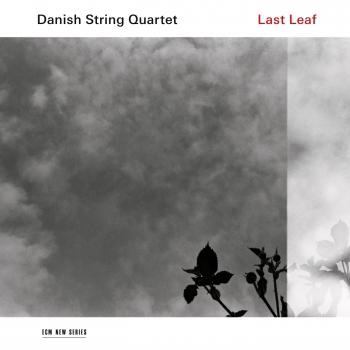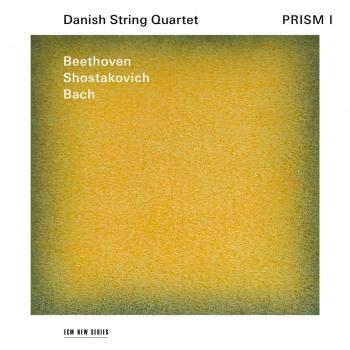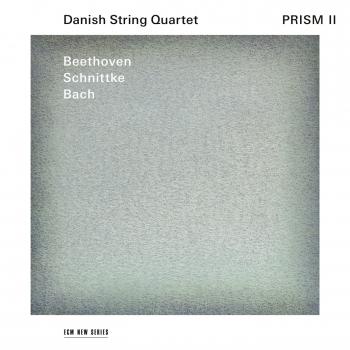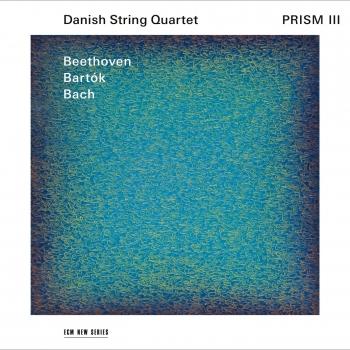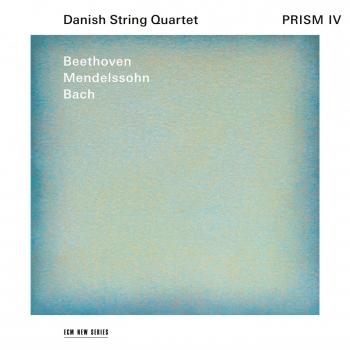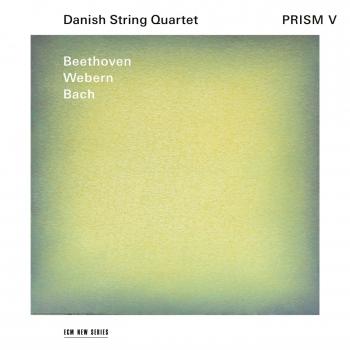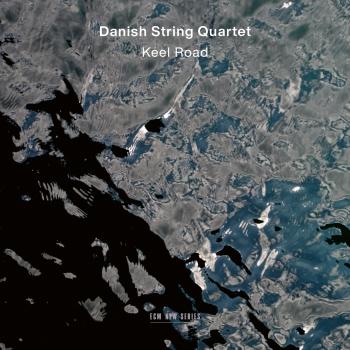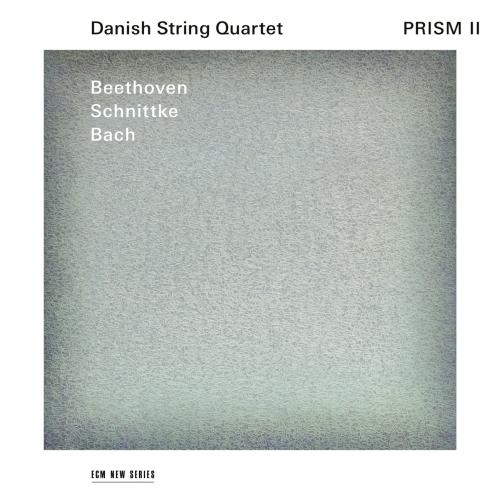
Prism II Danish String Quartet
Album info
Album-Release:
2019
HRA-Release:
13.09.2019
Label: ECM Records
Genre: Classical
Subgenre: Chamber Music
Artist: Danish String Quartet
Composer: Ludwig van Beethoven (1770–1827), Alfred Schnittke (1934-1998), Johann Sebastian Bach (1685-1750)
Album including Album cover Booklet (PDF)
I`m sorry!
Dear HIGHRESAUDIO Visitor,
due to territorial constraints and also different releases dates in each country you currently can`t purchase this album. We are updating our release dates twice a week. So, please feel free to check from time-to-time, if the album is available for your country.
We suggest, that you bookmark the album and use our Short List function.
Thank you for your understanding and patience.
Yours sincerely, HIGHRESAUDIO
- Johann Sebastian Bach (1685 - 1750): The Well-Tempered Clavier: Book 1, BWV 846-869:
- 1 The Well-Tempered Clavier: Book 1, BWV 846-869: Fugue in B Minor, BWV 869 (Arr. Förster for Strings) 06:48
- Alfred Schnittke (1934 - 1998): String Quartet No. 3:
- 2 String Quartet No. 3: 1. Andante 06:11
- 3 String Quartet No. 3: 2. Agitato 07:49
- 4 String Quartet No. 3: 3. Pesante 08:36
- Ludwig van Beethoven (1770 - 1827): String Quartet No. 13 in B-Flat Major, Op. 130:
- 5 String Quartet No. 13 in B-Flat Major, Op. 130: 1. Adagio ma non troppo – Allegro 09:52
- 6 String Quartet No. 13 in B-Flat Major, Op. 130: 2. Presto 02:00
- 7 String Quartet No. 13 in B-Flat Major, Op. 130: 3. Poco scherzando. Andante con moto ma non troppo 07:05
- 8 String Quartet No. 13 in B-Flat Major, Op. 130: 4. Alla danza tedesca. Allegro assai 03:22
- 9 String Quartet No. 13 in B-Flat Major, Op. 130: 5. Cavatina. Adagio molto espressivo 07:49
- 10 String Quartet No. 13 in B-Flat Major, Op. 130: 6. Große Fuge, Op. 133 (Ouverture. Allegro – Fuga) 16:44
Info for Prism II
The Danish String Quartet's Grammy-nominated Prism project links Bach fugues, late Beethoven quartets and works by modern masters. In volume two of the series, Bach's Fugue in Bb minor from the Well-Tempered Clavier (in the arrangement by Viennese composer Emanuel Aloys Förster) is brought together with Beethoven's String Quartet Op. 130 and Alfred Schnittke s String Quartet No.3 (composed in 1983). As the quartet explains, A beam of music is split through Beethoven's prism. The important thing to us is that these connections be experienced widely. We hope the listener will join us in the wonder of these beams of music that travel all the way from Bach through Beethoven to our own times. Recorded in historic Reitstadel Neumarkt and produced by Manfred Eicher.
Each of the albums in the Danish String Quartet's ongoing Prism project links one of the five late Beethoven quartets with a Bach fugue and a kindred-spirit work by a later master. Released last year, the Grammy-nominated first instalment of the series earned wide acclaim. The second volume of the series begins with the Fugue in B minor, BWV 869, which completes J.S. Bach’s Well-Tempered Clavier, Book I (in an arrangement by Viennese composer Emanuel Aloys Förster, an elder contemporary of Beethoven). As Prism I included a quartet by Shostakovich, Prism II features one Alfred Schnittke. Characteristically, Schnittke’s String Quartet No. 3 of 1983 echoes with the sound of ghosts, from the late 16 thcentury (Orlando Lassus and his Stabat Mater) to the mid-20 th century (Shostakovich and his musical monogram of DSCH – which, as Paul Griffiths points out in his booklet essay, can be sensed as a transposition of the first four notes of the theme from Beethoven’s titanic “Grosse Fugue”). The original version of Beethoven’s String Quartet No. 13 in B-flat Major, Op. 130, included the “Grosse Fugue” as its final movement – which is how the DSQ presents the piece on Prism II.
In a prefatory note to the five-album Prism series, DSQ violist Asbjørn Nørgaard explains that even with the groundbreaking, future-minded aspects of the late Beethoven quartets, “this music is far from being disconnected from the past. Rather, Beethoven was focusing deeply on tradition and the ‘old days’ during the last days of his life, and was especially obsessed with Bach’s Well-Tempered Clavier, from which he derived many of the melodic motifs in his five late quartets… What Beethoven did with this tradition, however, was mind-blowing. His late quartets were so extreme and brilliant that they changed the game. Every composer after Beethoven had to consider these works and somehow figure out how to carry the torch. Beethoven had taken a fundamentally linear development from Bach and exploded everything into myriad colors, directions and opportunities – much in the same way a prism splits a beam of light.”
Beethoven completed his six-movement Op. 130 in 1826. As the biggest of his late quartets, the Op. 130 ranges from the comic to the cosmic, from Haydnesque scherzo to Mahlerian love song and beyond. After the work’s initial performance, Beethoven’s publisher persuaded him to substitute a shorter, lighter-toned finale for the 15-minute-plus “Grosse Fugue,” its length and level of dissonance considered too much for audiences of the time. The “Grosse Fugue” was first published as a standalone work, as Op. 133. Performers today, like the DSQ, often favor the composer’s original intentions, using the “Grosse Fugue” as the
quartet’s finale. Encapsulating Schnittke’s polystylistic manner, his milestone String Quartet No. 3 takes the kaleidoscopic aspects of Beethoven’s Op. 130 into the late 20 th century. With the work’s opening quotation of Lassus, the DSQ evokes a Renaissance consort of viols before digging into keening dissonances with a full, modern tone. Across the work, Beethoven and Shostakovich, waltz and lament, eras and emotions “twist and turn” in Griffiths’ phrase, the music feeling unsettled, otherworldly and, ultimately, timeless.
Prism II comes as the DSQ embarks on a tour with concerts on both sides of the Atlantic, from Germany, Denmark and Belgium in September-October to a full, five-concert Prism cycle for California’s La Jolla Music Society in November. Referencing the links between Bach, Beethoven and the modernists who came after them, Nørgaard says: “The important thing to us is that these connections be experienced widely on an intuitive level. We hope the listener will join us in wonder at these beams of music that travel all the way from Bach through Beethoven as far as our own times.”
Danish String Quartet
Danish String Quartet
As a string quartet, we find ourselves at the core of the classical music world. On a daily basis we delve deeply into works by great masters such as Beethoven and Mozart, but we also play the occasional folk gig. Over the years we have been fortunate to study in many different places in masterclasses with renowned teachers and have had opportunities to perform in major concert halls across the world. Sometimes a friendly reviewer has written nice things about us too. We have participated in competitions and made some recordings as well. If you want to know more about all this stuff, check out the ‘press‘ page on our site, where you can download a PDF with all the text you could hope for.
Here’s a simpler story of the quartet: We are three Danes and one Norwegian cellist, making this a truly Scandinavian endeavor. We are often joking about ourselves being modern Vikings – perhaps a touch more harmless than our ancestors – we are not pillaging cities or razing the English coastline! We are simply your friendly neighborhood string quartet with above average amounts of beard.The three of us met very early in our lives in the Danish countryside at an amazing summer camp for enthusiastic amateur musicians. Not yet teenagers, we were the youngest players, so we hung out all the time playing football and chamber music together. During the regular school year we would get together often to play music and just have fun. We became best friends. In 2001, professor Tim Frederiksen of The Royal Academy of Music in Copenhagen got in touch with us and started coaching us on a regular basis. All of the sudden, at the ages of 15 and 16, we were a serious string quartet. It all happened so fast that none of us seemed to notice the transition.
Time passed and we grew up. We were enrolled at The Royal Academy of Music and our life as music students had begun. Funnily enough, none of us have any memory of our lives without the string quartet. In 2008 Norwegian cellist Fredrik joined in, generously adding to the amount of beard and general Vikingness of the group. We found him hidden away in a castle outside Stockholm. During his free time, Fredrik can be found fixing or sailing his sailboat somewhere in Scandinavia.The rest of us spend time with different hobbies – old cars, cooking, gaming, reading, playing, talking, and drinking. Yes, playing string quartets is our job, and yes it is hard work, but we mostly do it for pleasure, like we always did.There is so much amazing music to delve into, and our hope is to continue our travels through life and music together as a quartet. We want to be able to share our music with as many people as possible. And of course, the ultimate goal is to beat Valentin Berlinsky’s (Borodin String quartet) world record of “most years in the same chamber music group”. We will reach that goal around 2060 and on that day we will host a giant feast – you shall all be invited!
Booklet for Prism II







